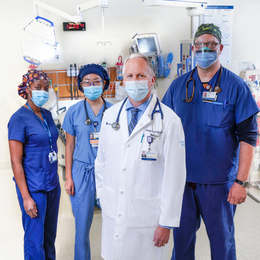
Safety First
In response to the COVID-19 crisis, Jefferson Health has evolved to offer stringent protections for community members in need of treatment for serious medical conditions.
The aftereffects of the public health crisis caused by COVID-19 will likely be felt for years to come. Apart from the loss of life and damage to the economy, Gerald C. Wydro, M.D., foresees an unfortunate side effect. He describes it as “a second pandemic,” referring to the implications of people who choose to forgo necessary medical care—even in an emergency—out of fear of contracting the virus.
If Dr. Wydro can offer one piece of advice, it’s this: Respect COVID-19, but do not fear it.
“If we’re respecting the virus, we’re acknowledging that it’s a highly infectious disease and taking precautions to fight it,” says Dr. Wydro, chairman of the department of emergency medicine for Jefferson Health – Northeast. “Fear of COVID-19 may make people not want to seek the care they need. I always tell people that if you are having chest pain, a stroke, or any other serious medical condition, come in and get the care you need.”
Given the frightening news headlines and evolving or contradictory information shared about the virus over the past few months, Dr. Wydro can understand people’s hesitancy. Even so, he suggests people should feel assured that Jefferson Health has done everything in its power to provide care in the safest possible environment.
“Do not feel afraid to seek the care that might save your life,” he adds. “Our emergency departments are here and ready.”
Taking Every Precaution
Jefferson Health – Northeast comprises three state-of-the-art locations: Jefferson Bucks Hospital in Langhorne, and Jefferson Frankford Hospital and Jefferson Torresdale Hospital in Northeast Philadelphia. The emergency department of each hospital provides expert care staffed by teams of specialty trained emergency medicine physicians and nurses.
Each state-of-the-art emergency department remains open to patients 24 hours a day, 365 days a year, offering advanced care for stroke, heart attack, and various other serious medical conditions. Jefferson Torresdale Hospital is also a Level II Trauma Center. In order to do so safely, all of Jefferson’s emergency departments have adopted stringent safety measures to protect patients and staff alike. These protocols include:
* Patient screening. Every patient and every visitor who enters the emergency department is screened for the virus. Those considered “high risk,” meaning they are symptomatic or in respiratory distress, are treated in doored rooms by practitioners with enhanced personal protective equipment. In addition, high-risk patients are not permitted visitors within the hospital as a way to lessen the likelihood of community spread. (Editor’s note: Jefferson also hosts mobile, outpatient testing sites for COVID-19 at locations in Center City, Abington, Northeast Philadelphia, and New Jersey, where patients can schedule a test with a formal request from their physician.)
* Universal masking. Every patient-facing staff member, whether “at the front desk or on the front lines,” wears a full face shield. In addition, every incoming patient, as well as every visitor, receives a facemask to wear for the duration of their stay. Dr. Wydro credits Jefferson for “going above and beyond” to source PPE—facemasks, gowns, gloves, etc.—at the enterprise level so that inventory is not an issue.
* Social distancing. Jefferson Health – Northeast has updated its visitation policy to accommodate one visitor per patient, assuming the patient and visitor have both been deemed “low risk” based on screening. Also, waiting areas have been converted to spaces where social distancing is applied, with seating spaced out six feet apart in accordance with recommendations from the U.S. Centers for Disease Control and Prevention.
* Hygiene and cleaning. Hand-sanitizing stations abound, and staff are encouraged to wash their hands for 20 seconds. In addition, treatment rooms are cleaned extensively to protect staff and reduce the risk of patient-to-patient infection.
* Telemedicine. Telemedicine has proven tremendously useful for all healthcare providers, and the benefits extend to Jefferson’s emergency departments, too. While Jefferson has long used a mobile teleconsulting system to communicate with patients, the health system’s emergency department has identified new opportunities to utilize telemedicine in light of the pandemic.
“After we make an initial assessment, we’re able to give the patient an iPad so the patient and physician can do additional follow-ups using telemedicine,” Dr. Wydro says. “This also reduces the amount of PPE we have to use, both for the physician and the patient. COVID-19 has prompted us to bring telemedicine onto the front line, and I never see it going away.”
Focused on ‘What’s Next’
Meeting a community’s health needs in the midst of an unprecedented health crisis has not been a simple task. Dr. Wydro credits the ingenuity of Jefferson’s leadership and staff for the health system’s coordinated response across all departments and campuses. Implementation of the Hospital Incident Command System allowed for a scalable structure to manage the event. Communication was enhanced through the use of a dedicated emergency operations command center to funnel information at all times.
“Most emergencies or disaster events, like a fire or hurricane, happen in a matter of hours or days,” he says. “You can plan for the event and staff for it accordingly, and once the event happens, it’s done. This is not a typical disaster. It’s going to be with us for a long time; we’re looking at it as a war, not a battle, that can go on for months or even a year. As a result, we’ve had to look at staffing and patient care differently.”
Dr. Wydro suggests Jefferson Health was prepared to handle an expected surge in COVID-19 cases, but he’s happy to report the surge was not nearly as large as initially predicted. Going forward, Dr. Wydro says his department remains nimble and focused on meeting the challenges to come.
“Now we’re asking, ‘What will the next surge look like, and how do we prepare for it with things like staffing and treatment space?’” he says. “Now that we’ve been through this once, how we can identify additional capacity to treat patients? How do we do rational testing and make sound decisions around patient care? How do we utilize the space that we have and use it for alternative treatment areas when necessary? And how do we rationally use the medicines to treat the disease now that there is some compelling data on their effectiveness in certain cases?”
In April and May, when statewide stay-at-home orders were firmly in place, Jefferson Health experienced a precipitous drop in visits to its hospitals’ emergency departments. While more people are now showing the confidence to seek the care they need, Dr. Wydro has witnessed a troubling trend: The individuals coming into the ER tend to be “higher acuity,” meaning they are generally sicker than patients had been pre-COVID-19. As a result, a higher percentage of people are being admitted to the hospital.
By continuing to reassure the public and showing it can safely treat patients in need of care, Dr. Wydro hopes to see that trend soon reverse, with patients coming into the hospital before they become so ill.
“Managing acute and chronic trauma and medical conditions is what we do,” he adds. “As a leadership team, we’re listening to, learning from, and regularly meeting with our colleagues across the city and across the country, and we continue to come up with the best ways to provide safe, highly effective care. We know it might look a little different, and our people might be wearing different types of equipment than they have in the past, but the same high level of care is there.”
Jefferson Health in the Northeast
For more information, visit Northeast.JeffersonHealth.org.
Photography by Robert Neroni
Click here to download a PDF of the story.
Published (and copyrighted) in Suburban Life magazine, July 2020.


